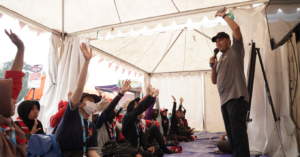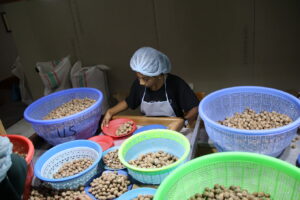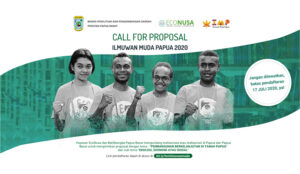
Teguh Ostenrik might never have thought that his love for Indonesia would reappear while diving. He took the German citizen registration form after living for about eleven years at der Panzer. Teguh’s decision was prevented by his friend through swearing and tearing up the registration paper. “You must be happy that you still have a motherland.”
At that time, in 1984, together with his best friend Teguh went on a vacation to Senggigi Beach, Lombok, West Nusa Tenggara. The combination of the beauty of coral and fish colors at Senggigi Beach inspires Teguh to create works. Using acrylic paint, there are five paintings created for his encounter with residents of Senggigi Beach. The painting series was named “Underwater World“.
Thirty years passed. Nature changes, no longer as pure as what Teguh imagined. Even so, the beauty of Senggigi Beach continues to imprint on Teguh’s mind until he makes his experience as advice. In the TEDx Sabang, Teguh said that he told his eldest son, “If you want to fall in love with Indonesia, dive in.”
There were no fish and coral, Teguh and his eldest son were greeted with a different reality. Senggigi Beach, known as the Lobster and Squid storehouse, has changed, like the Sahara Desert.
In the same year, Hotel Quinci Villas Mangsit, located on the edge of Senggigi Beach, held a residency exhibition, inviting a number of artists to beautify the hotel decor. Teguh, one of the invited artists, has his own thoughts based on his bitter experience while diving. When other artists decorate the hotel interior, Teguh just wants to put his work in the sea.
“The artist is not a decorator. I don’t want to decorate your hotel but I want to do something for Lombok, “Teguh told Scott Coffey, the hotel owner.
Firmly making ARTificial Reef installations; artwork that helps coral growth faster than natural growth. Domus Sepiae, the first ARTifical Reef installation, was placed 100 meters from the lip of Senggigi Beach. Domus is taken from the Latin word meaning “home” to be the hope that the installation work will become a new home for coral and marine life.
According to Tempo Magazine, Domus Sepiae measuring 6 x 10 meters. It takes 20 workers for 18 hours to move the installation weighing 3.2 tons from the mainland to sink completely. The Fine Art alumni of Lette Schule and Hochschule der Künste, Germany, cut Domus Sepiae into 16 modules 2 x 2 meters wide.
ARTificial Reef uses biorock technology invented by Wolf Hibert in 1974. Through iron that has been powered by low voltage electricity, biorock is able to accelerate coral growth three-five times compared to natural growth.
Teguh has made six ARTifical Reefs scattered in a number of waters; besides Domus Sepiae in Lombok, there is Domus Longus on Waha Beach, Wakatobi, South Sulawesi; Domus Musculi, Domus Piramidis Antennarius and Domus Selaroides on Sepa Island, North Jakarta; Domus Piramidis Dugong in Bangka, North Sulawesi.
Teguh’s work presents art as a form of solving environmental problems. Global warming makes coral bleach and end up dead. Not to mention the damage caused by human activities directly such as fishing activities and underwater tours to ship hit.
Citing Mongabay.co.id, coral bleaching is the most serious threat. At least four times coral bleaching has been fatal. In May – July 1983, coral bleaching caused 90 percent of coral deaths in the waters of the northern Natuna Sea, Sunda Strait, Java Sea, Bali and Lombok. Coral mortality reached 80 percent in the waters of Sumatra, North Natuna Sea, Java, Bali and Lombok from November 1997 to February 1998.
The third coral bleaching occurred in April – June 2010 which resulted in 30 percent dead coral cover in the northern and western waters of Sumatra, Bali, Lombok, and Wakatobi. Finally in June 2016, coral mortality reached 30-90 percent in the waters of East Nusa Tenggara, West Nusa Tenggara, south Java, west Sumatra, north Bali, Lombok, Karimun Jawa and Selayar. This is really worrying considering Indonesia’s strategic position in the Coral Triangle. In this region, Indonesia accounts for 51 percent of coral in the Coral Triangle (State of the Ocean Volume I, 2018).
As an artist, Teguh realizes that art can play a bigger role than as an “decorator”. According to Teguh, nature’s recognition of his work is far greater than other people’s recognition of his work through galleries, exhibitions and museum collections. “Domus Sepiae after two years under the sea is like a forest under the sea. Cuttlefish stayed there. We found barracudas coming there, meaning Domus Sepiae had become their canteen. Means there is already a lot of food. “
Teguh has a motto in building ARTificial Reef. Besides being useful for marine life, Teguh wants his work to also benefit the surrounding community. “Indeed, my motto for making Artificail Reef is how to make works of art that can open doors for people around them.”




